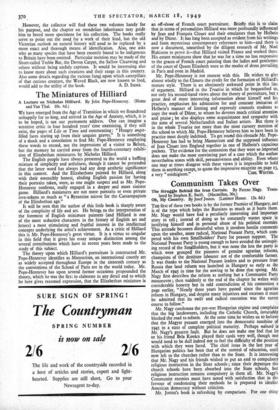The Miniatures of Hilliard
A Lecture on Nicholas Hilliard. By John Pope-Hennessy. (Home and Van Thal. 10s. 6d.)
WE have emerged from the Age of Transition in which we floundered unhappily for so long, and arrived in the Age of Anxiety, which, it is to be hoped, is not our permanent address. One can imagine a
sensitive critic in four hundred years' time examining, if they still exist, the pages of Life or Time and commenting : " Hungry angst-
filled faces staring up from their unquiet graves." It is something of a shock and a consolation to find Mr. Pope-Hennessy employing these words to record, not the impressions of a visitor to Belsen, but the memory he carried away from the fourth-centenary exhibi- ' tion of Elizabethan miniatures by Nicholas Hilliard.
The English people have always presented to the world a baffling mixture of simplicity and artfulness, though it cannot be pretended that the latter word has always had any deep aesthetic significance in this context. And the Elizabethans painted by Hilliard, along with their ostensibly honest, abiding English passion for having their portraits taken, were, as one might suspect and as Mr. Pope- Hennessy confirms, really engaged in a deeper and more sinister
game: Hilliard's miniatures are not mere, portraits or even private love-tokens so much as "a Byzantine mirror for the Caesaropapism of the Elizabethan age."
It will be seen that the author of this little book is sharply aware of the complicity of life and art. He brings to the interpretation of the foremost of English miniature painters (and Hilliard is one of the most seductive characters in the history of English art and letters) a most stimulating and fruitful interest in the intellectual concepts underlying the artist's achievement. As a critic of Hilliard this is Mr. Pope-Hennessy's great virtue. It is a virtue so singular in this field that it gives his essay unique distinction among the several contributions which have in recent years been made to the study of this subject.
The theory upon which Hilliard's portraiture is constructed Mr. Pope-Hennessy identifies as Mannerism, an international courtly art as widely accepted throughout Europe in the sixteenth century as the conventions of the School of Paris are in the world today. Mr. Pope-Hennessy has upon several former occasions propounded the theory, which he was the firs: to elaborate in any detail and to which he here gives reasoned expression, that the Elizabethan miniature is an off-shoot of French court portraiture. Briefly this is to claim that in terms of personalities Hilliard was more profoundly influenced by Jean and Francois Clouet and their emulators than by Holbein and by Diirer. It has long been accepted as evident from his writings and from mysterious contemporary references to him—and there is now a document, unearthed by the diligent research of Mr. Noel Blakiston to prove it—that Hilliard visited France and worked there. His extant miniatures show that he was for a time no less responsive to the graces of French court painting than the ladies and gentlemen of the court of Queen Elizabeth were to the modes of dress prevailing in Paris and even in Madrid.
Mr. Pope-Hennessy is not content with this. He wishes to give almost wholly to the Clouets the credit for the formation of Hilliard's mature style. There is an obstinately awkward point in this line of argument. Hilliard in the Treatise in which he bequeathed us, not only his second-hand views about the theory of portraiture, but a great deal of more interesting information about himself and his practice, emphasises his admiration for and constant imitation of Holbein's manner of limning and expressly counsels students to copy the work of Diirer, to whom he devotes much critical attention and praise ; he also displays some acquaintance and sympathy with the aims of several Netherlandish and Italian artists. But there is in the whole Treatise not more than the most cursory mention of the school to which Mr. Pope-Hennessy believes him to have been in practice most deeply indebted. To get round this obstacle Mr. Pope- Hennessy has had to bring Mannerism and the supposed influence of jean Clouet into England together in one of Holbein's capacious pockets. The evidence for the contention that they were so imported does not make the most convincing part of a case which the author nevertheless states with skill, persuasiveness and ability. Even where one may at times disagree with these views it is impossible to hold them in anything except, to quote the impressive misprint on page 15,






































 Previous page
Previous page